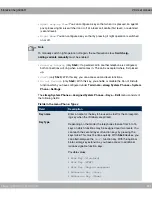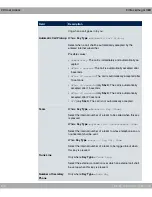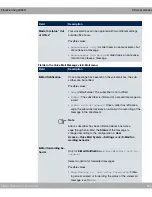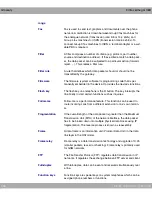
Glossary
2G
See GSM.
3DES
See DES.
3G
See UMTS.
4G
See LTE.
802.11
The 802.11 norm describes wireless LAN (WLAN). There are a vari-
ety of amendments: 802.11a: Gross data transfer rates: 54 Mbit/s,
frequency band: 5 GHz, 802.11b/g: Gross data transfer rates: 11
Mbit/s, frequency band: 2.4 GHz, 802.11g: Gross data transfer
rates: 54 Mbit/s, frequency band: 2.4 GHz, 802.11n: Gross data
transfer rates: 600 Mbit/s, frequency band: 2.4 GHz (optional: 5
GHz)
A-subscriber
The A-subscriber is the caller.
a/b interface
An a/b interface is used to connect an analogue terminal. In the
case of an ISDN terminal (terminal adapter) with a/b interface, a
connected analogue terminal is enabled to use the supported ISDN
performance features.
Access client
Client mode is an operating mode of a wireless access point (AP) in
which the latter behaves like a wireless adapter vis-a-vis the higher
level AP. With an AP run in client mode, individual computers or en-
tire sub-networks can be connected to higher level networks.
Access point
An access point (AP) is a device for wirelessly connecting clients
(computers). The AP thus serves to create a wireless network
(WLAN) and connect that WLAN to a wired Ethernet network
(bridging).
Accounting
Accounting refers to the recording of connection data, e.g. date,
time, connection duration, charging information and number of data
packets transferred.
Activity monitor
The activity monitor is used to oversee the status of physical and vir-
tual device interfaces.
Ad-hoc network
In an ad-hoc network, individual clients connect to an independent
wireless LAN via a wireless adapter. Ad-hoc networks work inde-
pendently, with no access point on a peer-to-peer basis. The ad-hoc
mode is also referred to as IBSS (Independent Basic Service Set)
Glossary
bintec elmeg GmbH
684
elmeg hybird 120 / hybird 130















































